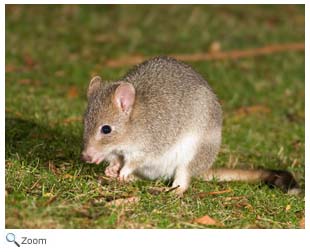Potoroidae - bettongs, potoroos, rat kangaroos
 There are 11 species of small marsupials in this family. They are found in Australia and Tasmania. They brown to grayish-brown. They have long hind feet; thick, long tails; small front legs, and small triangular heads. There are 11 species of small marsupials in this family. They are found in Australia and Tasmania. They brown to grayish-brown. They have long hind feet; thick, long tails; small front legs, and small triangular heads.
They hop like kangaroos and land on their hind legs and tails at when they hop at high speeds. They land on their front feet when they hop at slower speeds. They stand upright by balancing themselves on their long hind feet.
The species in this family are herbivores. Most species eat fungi and tubers. Some species may also eat insects.
World Status Key
 Least Concern Least Concern  Near Threatened Near Threatened  Vulnerable Vulnerable  Endangered Endangered  Critically Endangered Critically Endangered  Extinct in Wild Extinct in Wild  Extinct Extinct
Status and range is taken from ICUN Redlist. If no status is listed, there is not enough data to establish status.
US Status Key
 Threatened in US Threatened in US  Threatened in NH Threatened in NH  Endangered in US Endangered in US  Endangered in NH Endangered in NH  Introduced Introduced
US Fish and Wildlife and NH Fish and Game
New Hampshire Species |
|
North/Central American Species |
None
|
|
None |
Additional Information
Key:  Profile Profile  Photos Photos  Video Video  Audio Audio
Broad-faced Potoroo - Potorous platyops    
The broad-face potoroo was last recorded in 1875.
Source: Arkive Intended Audience: General Reading Level: Middle School
Brush-tailed Bettong - Bettongia penicillata    
The brush-tailed bettong was one found across much of australia. Today its population is limited to a few locations in southwest Western Australia.
Source: Arkive Intended Audience: General Reading Level: Middle School
Brush-tailed Bettong - Bettongia penicillata    
The brush-tailed bettong has bristly black fur at the tip of its tail.
Source: Animal Diversity Web Intended Audience: General Reading Level: Middle School Burrowing Bettong - Bettongia lesueur     
The burrowing bettong is also known as the boodie.
Source: Arkive Intended Audience: General Reading Level: Middle School
Burrowing Bettong - Bettongia lesueur    
The burrowing bettong was once found across mainland Australia. Today it is only found on islands off the coast of Australia.
Source: Animal Diversity Web Intended Audience: General Reading Level: Middle School
Desert Rat Kangaroo - Caloprymnus campestris   
The desert rat kangaroo has not been spotted since 1935.
Source: Animal Diversity Web Intended Audience: General Reading Level: Middle School
Gilbert's Potoroo - Potorous gilbertii    
Gilbert's potoroo is found in Western Australia.
Source: Arkive Intended Audience: General Reading Level: Middle School
Gilbert's Potoroo - Potorous gilbertii   
The introduction of foxes and feral cats has
caused to population of Gilbert's potoroo to decline.
Source: Animal Diversity Web Intended Audience: General Reading Level: Middle School
Long-footed Potoroo - Potorous longipes     
The long-footed potoroo is found in southeastern Australia.
Source: Arkive Intended Audience: General Reading Level: Middle School
Long-footed Potoroo - Potorous longipes    
The long-footed potoroo is threatened by habitat loss and fragmentation as well as by introduced predators like the fox and the dingo.
Source: Animal Diversity Web Intended Audience: General Reading Level: Middle School
Long-nosed Potoroo - Potorous tridactylus     
The long-nosed potoroo is found on the southeastern coast of Australia.
Source: Arkive Intended Audience: General Reading Level: Middle School
Long-nosed Potoroo - Potorous tridactylus    
The long-nosed potoroo is about the size of a rabbit.
Source: Animal Diversity Web Intended Audience: General Reading Level: Middle School
Northern Bettong - Bettongia tropica    
The northern bettong is found in Queensland, Australia.
Source: Arkive Intended Audience: General Reading Level: Middle School
Rufous Bettong - Aepyprymnus rufescens    
The rufous bettong is found from northeastern Queensland to northeastern New South Wales in Australia.
Source: Animal Diversity Web Intended Audience: General Reading Level: Middle School
Tasmanian Bettong - Bettongia gaimardi   
The Tasmanian bettong is found in eastern Tasmania.
Source: Arkive Intended Audience: General Reading Level: Middle School Tasmanian Bettong - Bettongia gaimardi    
The Tasmanian bettong uses its prehensile tail to pick up and carry grasses and brush when it is foraging for food or collecting nesting materials.
Source: Animal Diversity Web Intended Audience: General Reading Level: Middle School |

